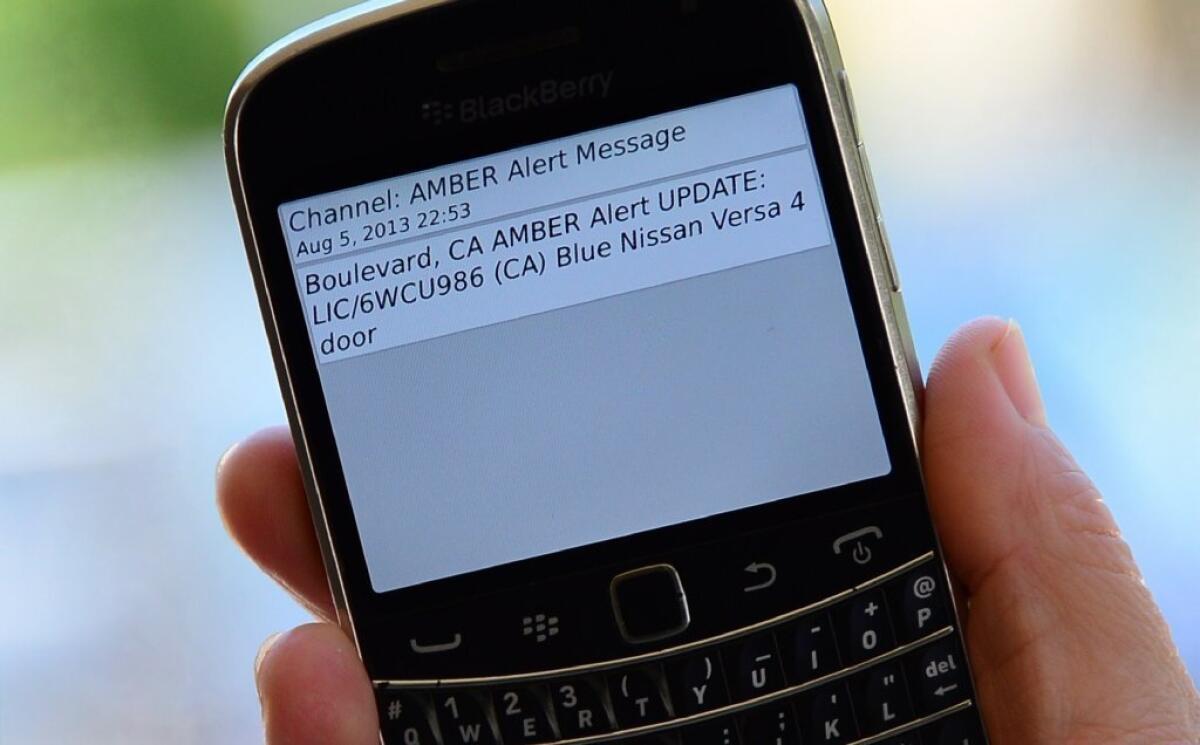That cellphone Amber Alert is worth the annoyance

- Share via
Like most everyone with a late-model cellphone in the state of California, I was startled Monday night to hear my phone suddenly blaring like a fire alarm shortly after 11. What the…? Scrambling to calm it down, I saw AMBER Alert Boulevard, CA (Where’s that?) LIC/6WCU986 Blue Nissan Versa 4 door…
In fact, I got the same text twice. After that, my first thought was: what do I do to stop getting anymore? How do I rejigger my iPhone so this doesn’t happen again?
That wasn’t an unusual response among cellphone users, even to an alert of a child abduction. In this case, the alert was triggered by the suspected kidnapping of one or two children by a man also suspected of killing their mother, whose body was found in the burning rubble of a house in a rural community.
It’s not that I don’t want to be a good citizen. It’s that I don’t want to be a citizen rousted from my bed by an insistent cellphone request to be on the lookout for a blue Nissan Versa last spotted in eastern San Diego County. If it’s 11 at night and I’m in my robe and bunny slippers in Brentwood, there’s really nothing I can do at that moment to help find them.
But authorities and wireless industry representatives think otherwise. For example, instead of seeing the suspect’s car on the road, you may have seen it parked somewhere earlier or know the owner. And this: “The first three hours of an abduction are the most important time to get the information out,” said California Highway Patrol spokesman Mike Harris. Unfortunately, in this case, authorities believe the children were kidnapped Saturday evening. Still, they needed to put out what they knew as soon as they knew it.
And this information travels a bit of a circuitous route to your cellphone. In this instance, the San Diego County Sheriff’s Department and the local Amber Alert coordinator decide the information meets the criteria for an alert and write it up. It gets sent to the Highway Patrol, which sends it to other law enforcement and the media and the changeable message signs on the freeways.
According to Brian Josef, assistant vice president of regulatory affairs for CTIA-The Wireless Assn., the information is sent to FEMA and then the message goes out over a special wireless channel to targeted geographic areas. Phone service carriers do not touch or question the message.
Whether your cellphone gets called depends only on whether you’re in the geographic area where authorities want to alert you. So, if you were in New York on Monday night with your California cell, you would not have been alerted. But conversely, if a New Yorker with a cellphone was in California, that phone would have been alerted. If it’s that geo-precise, why not just buzz the phones that are on the roads and in the best position to be on the lookout? Because that’s not the way wireless architecture works. Cellphone towers cover wide swaths; they can’t pinpoint ribbons of road.
But here’s something to think about: last month, an Amber Alert went out across cellphones in Cleveland for an 8-year-old who was not returned home by his non-custodial father. The car that was described in the alert was spotted by a group of people at a diner who called the authorities. The child was recovered.
It’s annoying to be spooked by your cellphone late at night. But now that we all know what it sounds like to get the Amber Alert, maybe we won’t be so annoyed next time. (We could also get Emergency Alerts.)
The most important thing is for law enforcement and Amber Alert coordinators to use this cell alerting system judiciously and sparingly. Do it too many times, and people will ignore it — like those car alarms -- or disable the alert message function altogether on their phones.
I could tell you how to disable it on an iPhone 5, but I won’t. I’ve left mine on, and I suggest everyone do the same.
ALSO:
Let’s end the obsession with women’s wombs
More to Read
A cure for the common opinion
Get thought-provoking perspectives with our weekly newsletter.
You may occasionally receive promotional content from the Los Angeles Times.







